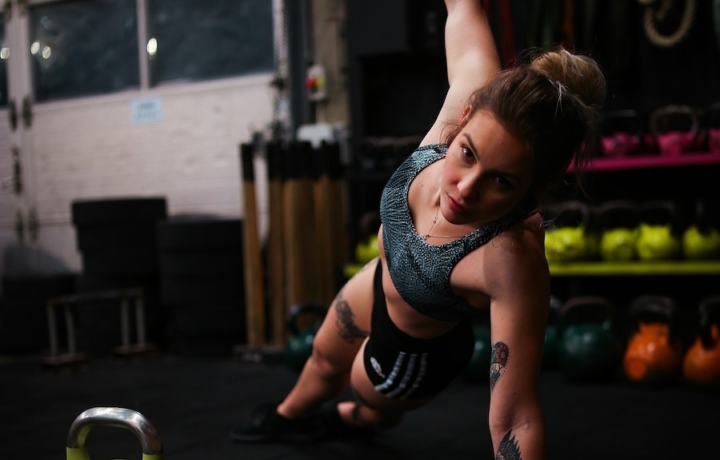Exercise
Elbow Up And Down Dynamic Plank

Elbow Up And Down Dynamic Plank
How to Perform
- Start in a high plank position with your wrists directly under your shoulders, feet hip-width apart, and body forming a straight line from head to heels.
- Engage your core by drawing your navel toward your spine and squeeze your glutes to maintain a neutral spine position.
- Lower your right arm to place your right elbow directly beneath your shoulder while maintaining the high plank position with your left arm.
- Lower your left arm to place your left elbow beneath your shoulder, now in a forearm plank position with both elbows under your shoulders and forearms parallel.
- Push through your right palm to straighten your right arm, returning it to the high plank position while keeping your hips stable and level.
- Push through your left palm to straighten your left arm, returning to the full high plank position while breathing steadily.
- Repeat the sequence by lowering right elbow, then left elbow, followed by extending right arm, then left arm, maintaining a consistent rhythm and stable core.
- Exhale during moments of exertion (when pushing back up) and inhale during the lowering phase, maintaining body alignment throughout the entire movement pattern.
Important information
- Keep your hips level throughout the entire exercise – avoid rotating or allowing them to pike up or sag down.
- Maintain tension through your core and glutes at all times to protect your lower back.
- If you experience wrist discomfort, try gripping the floor with your fingertips or placing your hands on dumbbells for a neutral wrist position.
- Start with shorter sets (5-8 repetitions per side) and gradually build up endurance as you master the movement pattern.

Elbow Up And Down Dynamic Plank
Exercise Details
Primary Muscles
Muscle Groups
Mechanic
Risk Areas
Built for progress
Take the guesswork out of training
Create personalized AI-powered workout plans that evolve with you. Train smarter, track every rep and keep moving forward, one workout at a time.






The Elbow Up And Down Dynamic Plank takes the traditional plank exercise to new heights by introducing an element of movement that challenges your stability and engages multiple muscle groups simultaneously. This intermediate-level movement primarily targets your abs, front deltoids, and triceps, making it an excellent addition to your HIIT, CrossFit, or bodybuilding routine.
When you incorporate this dynamic variation into your workout regimen, you're essentially combining the isometric benefits of a standard plank with the additional muscular recruitment that comes from the up-and-down motion. Your core remains in constant engagement as it works to stabilize your body throughout the exercise, preventing your hips from sagging or pike-ing upward. This continual tension is what makes the Elbow Up And Down Dynamic Plank particularly effective for building core endurance.
The beauty of this exercise lies in its efficiency. In just one movement, you're developing functional strength across multiple planes while simultaneously improving your muscular endurance. Your front deltoids act as key stabilizers during the transition phases, while your triceps kick in powerfully as you press up from the elbow position. Meanwhile, your abdominals work overtime to maintain proper alignment throughout the entire sequence.
For those looking to elevate their fitness routine, this exercise serves as an excellent progression from standard planks. The dynamic component significantly increases the cardiovascular demand, making it perfect for those high-intensity intervals in your HIIT workout. Crossfit enthusiasts appreciate how it builds the foundational strength needed for more complex gymnastic movements, while bodybuilders value the way it simultaneously engages multiple muscle groups for efficient training.
What truly sets this exercise apart is its scalability. As your core strength and endurance improve, you can increase the duration or number of repetitions to continue challenging yourself, ensuring continuous progress in your fitness journey without needing to completely change your routine.
FAQ - Elbow Up And Down Dynamic Plank
This exercise primarily targets your core muscles (especially the rectus abdominis and transverse abdominis), while significantly engaging your front deltoids and triceps during the up-and-down transitions. Your chest, back, and glutes also work as stabilizers throughout the movement.
Beginners can start with a partial squat depth and press lighter weights or no weights at all. You can also separate the movements initially, mastering the squat first, then the overhead press, before combining them into one fluid motion.
The most common mistakes include rounding your lower back, rotating your hips instead of keeping them square, rushing through the movement, and not hinging properly at the hips. Focus on maintaining a neutral spine, moving with control, and keeping your standing knee slightly soft rather than locked.
For optimal results, include the Bodyweight Single Leg Deadlift 1-3 times weekly, performing 2-3 sets of 8-12 repetitions per leg. This frequency provides enough stimulus for strength development while allowing adequate recovery, especially if you're also doing other posterior chain exercises.
Yes, you can increase difficulty by extending the duration of each position, adding more repetitions, or incorporating resistance by placing a weight plate on your back. For an advanced variation, try performing the movement with one leg lifted off the ground to further challenge your stability.








